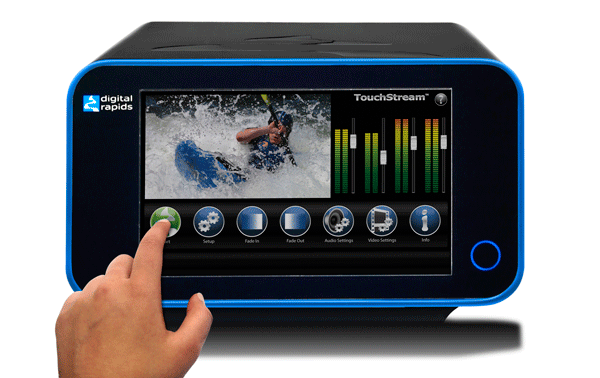Review: Digital Rapids TouchStream 1.2
TouchStream 1.2 is a beefier upgrade to Digital Rapids' compact, touchscreen-enabled live encoding box that is head-and-shoulders above similar devices when it comes to "power-up and encode" in just a few simple steps.
My first review of Digital Rapids' TouchStream was based on an extended walk-through of a prototype during the National Association of Broadcasters show in Las Vegas in April 2009.
A year-and-a-half later, I had a chance to sit down with the newer, beefier TouchStream at the Streaming Media Europe event in London, and what I saw was a natural progression of the streaming box in several different areas.
Before launching into the improvements of this touch-screen-enabled live encoding box, let's talk first about the unit itself.
What's in (and on) the Box?
About the size of a shoebox, the TouchStream's entire front surface is covered with a blue-neon-ringed touchscreen that swivels up for easy viewing at either eye level or from a few feet above-ideal for both use in both a flypack and tabletop configurations.
Digital Rapids TouchStream 1.2, front view, showing the neon-ringer touchscreen
The back of the unit has two USB connectors, which on the newest 1.2 software version of the TouchStream application, allows a USB Wi-Fi access card to leverage the embedded WindowsXP network stack.
The back of the unit also contains an Ethernet connection and a multi-pin connector, attached to the internal video card. The card is capable of multiple configuration types, from composite to S-video to component, with balanced and unbalanced audio, plus an optional SDI connection.

Digital Rapids TouchStream 1.2, rear view with connectivity options
A blue ring glows in the bottom-right corner of a solid black screen, and once you've touched it, the whole unit springs to life.
What's New in v. 1.2
Shiny, bright object-interest aside, the Digital Rapids TouchStream takes into account many of the production issues that a portable encoding solution has to contend with. As I mentioned in my initial review, TouchStream has been one of few machines I've reviewed over the years that lived up to the hype of being a truly self-contained system.
"A portion of the TouchStream challenge was to make this an easy to use interface, so we showed it to potential customers in markets that we couldn't address with our initial products," says Mike Nann, Digital Rapids' Director of Marketing. "We didn't want to lose the comprehensive tweaking power that set our products apart so the goal was flexibility and ease of use, simultaneously."
That tweaking has expanded in software version 1.2 for a variety of options.
As mentioned above, the USB connections are capable of providing WiFi connectivity. Getting to a wireless network is a bit tricky, and a keyboard is required, which eliminates the never-use-a-keyboard benefit of the TouchStream. Wireless networks with dynamic provisioning-such as the hotel we tested in-may cause potential issues; our system continued to show a "disconnected" status even after it obtained an IP address and was successfully streaming.
Another benefit of the dual USB connectors is the ability to use a USB flash drive as external storage. On the test version, we used the external USB storage to caching segment for the optional streaming to iOS devices (iPhones and iPads). Company representatives say the shipping option of iOS segmenting / streaming requires a second internal hard drive, but it's nice to see a USB flash drive can be used in a pinch.